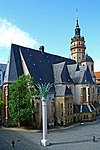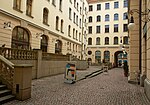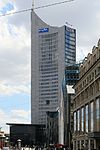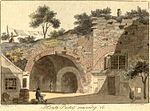Leipzig University

Leipzig University (German: Universität Leipzig), in Leipzig in the Free State of Saxony, Germany, is one of the world's oldest universities and the second-oldest university (by consecutive years of existence) in Germany. The university was founded on 2 December 1409 by Frederick I, Elector of Saxony and his brother William II, Margrave of Meissen, and originally comprised the four scholastic faculties. Since its inception, the university has engaged in teaching and research for over 600 years without interruption. Famous alumni include Leibniz, Goethe, Leopold von Ranke,William Samoei Ruto, Raila Amolo Odinga, Friedrich Nietzsche, Robert Schumann, Richard Wagner, Tycho Brahe, Georgius Agricola, Angela Merkel and the nine Nobel laureates associated with the university.
Excerpt from the Wikipedia article Leipzig University (License: CC BY-SA 3.0, Authors, Images).Leipzig University
Kurt-Masur-Platz, Leipzig Leipzig-center (Mitte)
Geographical coordinates (GPS) Address Website External links Nearby Places Show on map
Geographical coordinates (GPS)
| Latitude | Longitude |
|---|---|
| N 51.338888888889 ° | E 12.378611111111 ° |
Address
Universität Leipzig
Kurt-Masur-Platz
04109 Leipzig, Leipzig-center (Mitte)
Saxony, Germany
Open on Google Maps











